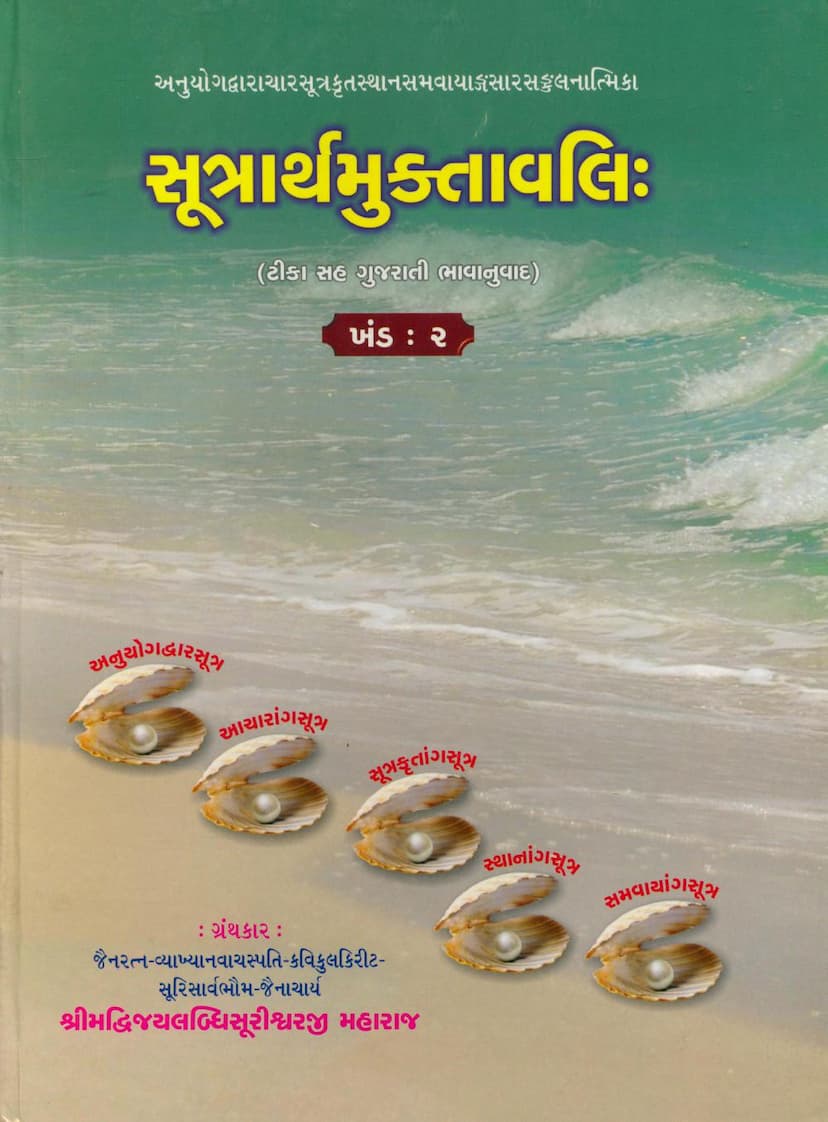Sutrarth Muktavali Part 02
Added to library: September 2, 2025

Summary
Summary of "Sutrarth Muktavali Part 02" (Samavayaanga Sutra Muktāvalikā section)
This document, "Sutrarth Muktavali Part 02," is the second volume of a commentary on Jain Agamas, specifically focusing on the Samavāyānga Sūtra. Attributed to Acharya Shrimad Vijavlabdhisuri Maharaj and compiled/edited by Ganivar Vikramsenvijay, this text provides a detailed analysis and translation of the Samavāyānga Sūtra.
Core Content and Structure:
The text systematically breaks down the Samavāyānga Sūtra, which is known for its classification of Jain principles and entities based on numbers, primarily from one to ten, and extending to much larger numbers. The "Sutrarth Muktavali" aims to elucidate the meaning (arth) of these intricate sutras with a commentary (tikā) and Gujarati translation.
Key Themes and Subject Matter:
The Samavāyānga Sūtra, as presented in this commentary, covers a vast spectrum of Jain philosophy and cosmology. Based on the extensive index (vishayānukramaṇikā) and chapter introductions, the key themes include:
- Classification and Enumeration: The core of the Samavāyānga is the classification of various entities, concepts, and phenomena according to numerical order (e.g., one truth, two types of actions, ten types of celestial bodies). This forms the structural backbone of the text.
- Soul (Ātmā): The nature of the soul, its oneness, its attributes (like consciousness), and its existence are discussed extensively, often in response to other philosophical viewpoints.
- Jiva and Ajiva: The fundamental Jain categories of living beings (jiva) and non-living substances (ajiva) are analyzed in detail, along with their various classifications.
- Cosmology and Geography: The text delves into the structure of the universe, including descriptions of Jambudvipa, Meru mountain, various continents, oceans, and the different types of hells (naraka), heavens (deva-loka), and their inhabitants.
- Karma and Liberation: Concepts of karma, bondage (bandha), liberation (moksha), influx (āsrava), cessation of influx (saṃvara), and shedding of karma (nirjarā) are explained. The path to liberation is also a recurring theme.
- Knowledge and Perception: Different types of knowledge (jñāna) and perception (darśana) are enumerated and explained, including sensory knowledge (mati), scriptural knowledge (śruta), clairvoyant knowledge (avadhi), telepathic knowledge (manahparyaya), and omniscience (kevala jñāna).
- Conduct and Ethics: The text details various aspects of Jain conduct, including vows (vrata), disciplines (saṃyama), ethical conduct (ācāra), penances (tapas), and the conduct of monks (nirgrantha) and nuns.
- Various Categories of Beings: The classification extends to different types of beings, including hell-dwellers (nairayika), celestial beings (jyotiṣka, vaiyamānika), humans, animals (tiryañc), and the various classes of senses (ekendriya, dvīndriya, etc.).
- Time and Cycles: The concepts of time, cosmic cycles (yuga), and the duration of various states of existence are discussed.
- Philosophical Debates: The text engages with and refutes the views of other philosophical schools (tīrthāntariyas) on various topics, establishing the Jain perspective.
- Specific Topics: A significant portion of the text is dedicated to detailed explanations of specific concepts such as the different types of body formation (śarīra), yogas (manas, vacana, kāya), vows and their subdivisions, different types of suffering (dukha), and the causes of attachment and aversion.
- Purity and Conduct of Monastics: A considerable amount of detail is provided on the rules and regulations pertaining to the conduct of Jain ascetics, including their possessions, conduct in various situations, and the penalties for transgressions.
- Rituals and Practices: Aspects related to fasting, austerities, and other religious practices are mentioned.
Thematic Approach:
The commentary emphasizes the foundational principles of Jainism, such as anekānta (non-absolutism), syādvāda (the doctrine of conditional predication), and the importance of right faith (samyakdarśana), right knowledge (samyakjñāna), and right conduct (samyakcāritra) as the path to liberation.
Overall Purpose:
The "Sutrarth Muktavali" aims to make the profound and complex teachings of the Samavāyānga Sūtra accessible to a wider audience, particularly through its Gujarati translation and detailed commentary. It serves as a valuable resource for Jain scholars, students, and anyone seeking a deeper understanding of the Jain Agamas. The emphasis on the "essence" (sārārtha) highlights the text's goal of extracting the core teachings from the original sutras.
Note on the Authorship and Publisher:
The attribution to Acharya Shrimad Vijavlabdhisuri Maharaj and the publication by Labdhibhuvan Jain Sahitya Sadan indicate the text originates from a respected lineage within Jain scholarship, likely the Tapagachchha tradition, given the mention of "Tapagachchha Sangha" in the acknowledgments. The mention of "JAIN EDUCATION INTERNATIONAL FOR PRIVATE AND PERSONAL USE ONLY" suggests a specific dissemination context.